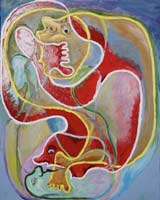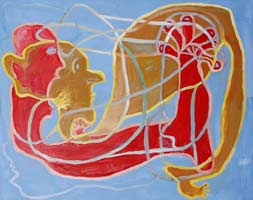4. Movement
As we saw with the construction of the labyrinth image, the movement of the knot is at the origin off its final image. This image corresponds to a specific reading of a movement . With this movement, the symbol of the labyrinth also includes the concept of cyclical time: the role of this movement requires examination .
With the theory of relativity, movement itself has openly become the subject of art. With cubism, the movement of the observer permits changing and interlocking points of view. With futurism, the motion of the object modifies its appearance which then resembles a trace; the object is partially replaced by its wake. Exploiting the possible consequences of these modifications, Duchamp and Picabia pursued this movement to suggest a mutation of the object. Early on, I also questioned the role of movement in perception, asking myself what I was painting and if it was really what I was seeing, and how was I seeing it. What path does the eye follow to gather and unite a flock of sensations? What image was produced when this flock scattered or when some of its elements escaped? What image of a tree captures a bee gleaning around and through it ? Supposing that perception slowed down indefinitely, what worldview do you get when walking or living in the world ? The more I tried to directly observe and analyze my vivid perception, the more it seemed impossible. All I was able to do was to dream up images, which could integrate themselves during the course of perception by combining incomplete or ambiguous surveys or glances. This suggested, how the attention to the movement could both produce nonsense as well as lend meaning to perception. What is true and invisible can often reveal itself only through wild hypotheses and lucky lies. « Everything comes to pass as if my power to reach the world and my power to entrench myself in phantasms only came one with the other. »1.
A) For example, in the series called “Jacob’s stepladder”, by assembling kaleidoscopically different views of the stepladder, I tried to suggest how Jacob, following on the ladder the angel who has visited him, might have discovered numerous unknown worlds. The methodic destruction of the object suggests the possible meaning of the symbol and the poetry attached to it. In relation to this, the series also evokes the subtle question of the difference between Jacob’s ladder and the Tower of Babel; two opposites approach attaining knowledge. » It is the title of one of the paintings”.

n°38 Jacob's stepladder serie












